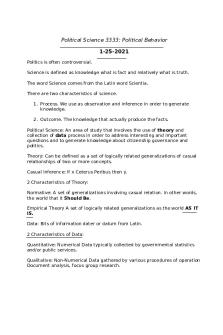Reels 3333 3 PDF

| Title | Reels 3333 3 |
|---|---|
| Author | Ambareena Nenshi |
| Course | Death and the Afterlife |
| Institution | Mount Royal University |
| Pages | 4 |
| File Size | 36.4 KB |
| File Type | |
| Total Downloads | 89 |
| Total Views | 134 |
Summary
Lecture notes for midterm exam and final exam - key terms ideas concepts etc....
Description
RELS 3333 – Midterm 2 Study Guide Judaism • How do we know about Ancient Judaism? o Dual Torah means “the law” ▪ Oral Torah – storytelling to remind themselves of their identities ▪ Written Torah (Pentateuch) – the five books • Genesis, Exodus, Leviticus, Numbers, Deuteronomy • What is the earliest account of Jewish view of life after death in Torah? o Book of Genesis ▪ Spoken by Jacob, patriarch of the Israelites, who is surrounded by his sons ▪ Burying with kin in a cave ▪ “gathering to his people”, “slept with his ancestors” • What does the passage in the Book of Genesis tell us about their view of death? o There was no philosophical teachings on life after death in Ancient Judaism o Views were provided via stories from the Book of Genesis • Did people have individual fates? o Israelite identity was connected with their group/tribe/family clan o No individual identity or soul • What was the lifestyle of Israelites like?
o Semi-nomadic lifestyle • Who is the figure Abraham in the passage? o Abraham is the patriarch • What is a patriarch? What is a patriarch’s responsibility? o A patriarch is the leader of a tribe, and their responsibility is to protect the tribe and keep it safe • Why was Abraham’s story significant to Jews, Christians, and Muslims? o For Jews, it led to the development of the oral Torah and the covenant with God o For Christians, he was a major figure for the religion and the father to Isaac o For Muslims, he was the father to Ismael and a prophet himself • What were the customs surrounding the family tomb? o The family tomb led to the realm of ancestors, a connection between the dead and the living o Bodies were wrapped in linen and had to be watched for three days to make sure the person was deceased and to protect the body from scavenger animals • Why were caves ideal for burial? o Caves were ideal because bodies could then be buried deep underground where ancestors were believed to have a shadowy existence; block the smell o Caves of the Patriarchs
• What do the passages reveal about the Torah’s attitude toward feeding the dead? o Torah condemned feeding the dead o The dead would be fed by leaving food at the tombs for the person to consume • Why were tombs built with “windows”? o Used to pour wine into the tombs for the dead to feast on • What elements were influenced by Egyptian Religion? o Importance of remembering the bloodline and dreams o Importance of the priesthood o Shrines and temples • Who was Joseph? o Grandson of Abraham, son of Isaac • Why did Joseph go to Egypt? o He is sold to one of the Pharaoh’s Captains, Potiphar, after being betrayed by his brothers • How did Joseph become imprisoned? o Potiphar’s wife tries to seduce Joseph, but he declines; she accuses him of rape and Joseph is then imprisoned o He meets the cupbearer and the baker of the Pharaoh in prison ▪ Tells the cupbearer to mention him to the Pharaoh o What was the role of dreams in Egyptian religion? ▪ Dreams offer warnings, advice, and prophecies; gods communicate with humans through dreams
• Why was Joseph released from prison? o After the cupbearer is free from imprisonment, he is reinstated by the Pharaoh; after the Pharaoh dreams of 7 famished cows eating 7 healthy cows, and thin grains eating up healthy grains, the cupbearer gets Joseph released in order to interpret the dream ▪ What was the meaning of this dream? What advice did Joseph give to the Pharaoh? ▪ The dream meant 7 years of abundance will be followed by 7 years of famine; Joseph suggested that the Pharaoh store food for the famine...
Similar Free PDFs

Reels 3333 3
- 4 Pages

Math 3333 2016 homework 3
- 1 Pages

Political Behavior 3333
- 18 Pages

Nombres Reels- univ Lille 1
- 14 Pages

Links for Outfits in Reels
- 6 Pages

PSCI 3333 Syllabus.2021 Revised
- 4 Pages

Fins - ME 3333 Allison Hubel
- 3 Pages

3
- 4 Pages

3
- 5 Pages

Tema 3 - Apuntes 3
- 5 Pages

Semana 3 proyecto 3
- 3 Pages
Popular Institutions
- Tinajero National High School - Annex
- Politeknik Caltex Riau
- Yokohama City University
- SGT University
- University of Al-Qadisiyah
- Divine Word College of Vigan
- Techniek College Rotterdam
- Universidade de Santiago
- Universiti Teknologi MARA Cawangan Johor Kampus Pasir Gudang
- Poltekkes Kemenkes Yogyakarta
- Baguio City National High School
- Colegio san marcos
- preparatoria uno
- Centro de Bachillerato Tecnológico Industrial y de Servicios No. 107
- Dalian Maritime University
- Quang Trung Secondary School
- Colegio Tecnológico en Informática
- Corporación Regional de Educación Superior
- Grupo CEDVA
- Dar Al Uloom University
- Centro de Estudios Preuniversitarios de la Universidad Nacional de Ingeniería
- 上智大学
- Aakash International School, Nuna Majara
- San Felipe Neri Catholic School
- Kang Chiao International School - New Taipei City
- Misamis Occidental National High School
- Institución Educativa Escuela Normal Juan Ladrilleros
- Kolehiyo ng Pantukan
- Batanes State College
- Instituto Continental
- Sekolah Menengah Kejuruan Kesehatan Kaltara (Tarakan)
- Colegio de La Inmaculada Concepcion - Cebu




